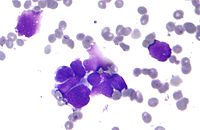
Photo from wikipedia
We have developed an adiabatic calorimeter with a small glass Hg cell to calibrate capsule-type standard resistance thermometers (SPRTs) at the triple point of Hg (TPHg), which is one of… Click to show full abstract
We have developed an adiabatic calorimeter with a small glass Hg cell to calibrate capsule-type standard resistance thermometers (SPRTs) at the triple point of Hg (TPHg), which is one of the defining fixed point of the International Temperature Scale of 1990 (ITS-90). Using this system with high-purity Hg (99.999 99 %), we calibrated SPRTs at the TPHg and evaluated the uncertainty of the calibration. Compared with a calibration system at the National Metrology Institute of Japan (NMIJ/AIST), which uses a large stainless steel Hg cell, for a small cell in an adiabatic calorimeter the temperature distribution from hydrostatic pressure can be suppressed. In addition, the influence of heat flux can also suppressed by using the adiabatic calorimeter. Consequently, the standard combined uncertainty for the realization of TPHg was estimated to be 0.12 mK, much less than the uncertainty of the conventional system using the large stainless Hg cells. Furthermore, by measuring the cooling curve of Hg at different cooling rates, we confirmed that the degree of supercooling of high-purity Hg in the small glass cell reached approximately 18 K, which is much larger than that achievable in not only large Hg cells but also small cells. This large supercooling may be related to the high purity of the Hg employed, the small hydrostatic height of the Hg, and/or the surface contact between Hg and cell.
Journal Title: International Journal of Thermophysics
Year Published: 2019
Link to full text (if available)
Share on Social Media: Sign Up to like & get
recommendations!